Priest
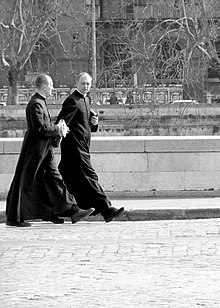

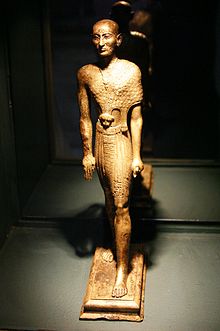
Apriestis areligious leaderauthorized to perform the sacredritualsof a religion, especially as a mediatory agent between humans and one or moredeities.They also have the authority or power to administer religious rites; in particular, rites of sacrifice to, and propitiation of, a deity or deities. Their office or position is the "priesthood", a term which also may apply to such persons collectively. A priest may have the duty to hear confessions periodically, give marriage counseling, provide prenuptial counseling, give spiritual direction, teachcatechism,or visit those confined indoors, such as the sick in hospitals and nursing homes.
Description
[edit]According to thetrifunctional hypothesisof prehistoricProto-Indo-European society,priests have existed since the earliest of times and in the simplest societies, most likely as a result ofagriculturalsurplus and consequentsocial stratification.[1]The necessity to read sacred texts and keep temple or church records helped foster literacy in many early societies. Priests exist in many religions today, such as all or some branches ofJudaism,Christianity,Buddhism,Shinto,andHinduism.They are generally regarded as having privileged contact with thedeityor deities of the religion to which they subscribe, often interpreting the meaning of events and performing the rituals of the religion. There is no common definition of the duties of priesthood between faiths; but generally it includes mediating the relationship between one's congregation,worshippers,and other members of the religious body, and its deity or deities, and administering religiousritualsand rites. These often include blessing worshipers with prayers of joy at marriages, after a birth, and atconsecrations,teaching the wisdom anddogmaof the faith at any regular worship service, and mediating and easing the experience of grief and death at funerals – maintaining a spiritual connection to theafterlifein faiths where such a concept exists. Administering religious building grounds and office affairs and papers, including any religious library or collection ofsacred texts,is also commonly a responsibility – for example, the modern term forclerical dutiesin a secular office refers originally to the duties of acleric.The question of which religions have a "priest" depends on how the titles of leaders are used or translated into English. In some cases, leaders are more like those that other believers will often turn to for advice on spiritual matters, and less of a "person authorized to perform the sacred rituals." For example,clergyinRoman CatholicismandEastern Orthodoxyarepriests,as with certain synods ofLutheranismandAnglicanism,though other branches ofProtestant Christianity,such as Methodists and Baptists, useministerandpastor.The termspriestandpriestessare sufficiently generic that they may be used in ananthropologicalsense to describe the religious mediators of an unknown or otherwise unspecified religion.
In many religions, being a priest or priestess is a full-time position, ruling out any other career. Many Christian priests and pastors choose or are mandated to dedicate themselves to their churches and receive their living directly from their churches. In other cases, it is a part-time role. For example, in the earlyhistory of Icelandthe chieftains were titledgoði,a word meaning "priest". As seen in thesagaofHrafnkell Freysgoði,however, being a priest consisted merely of offering periodic sacrifices to theNorsegods and goddesses; it was not a full-time role, nor did it involve ordination.
In some religions, being a priest or priestess is by human election or human choice. In Judaism, the priesthood is inherited in familial lines. In atheocracy,a society isgovernedby its priesthood.
Etymology
[edit]The word "priest", is ultimately derived from Latin viaGreekpresbyter,[2]the term for "elder", especially elders of Jewish or Christian communities inlate antiquity.The Latinpresbyterultimately represents Greekπρεσβύτεροςpresbúteros,the regular Latin word for "priest" beingsacerdos,corresponding toἱερεύςhiereús.
It is possible that the Latin word was loaned intoOld English,and only from Old English reached other Germanic languages via theAnglo-Saxon missionto the continent, givingOld Icelandicprestr,Old Swedishpräster,Old High Germanpriast.Old High German also has the disyllabicpriester, priestar,apparently derived from Latin independently viaOld Frenchpresbtre.
An alternative theory makespriestcognate with Old High Germanpriast,prest,fromVulgar Latin*prevost"one put over others", from Latinpraepositus"person placed in charge".[3]
That English should have only the single termpriestto translatepresbyterandsacerdoscame to be seen as a problem inEnglish Bible translations.Thepresbyteris the minister who both presides and instructs a Christian congregation, while thesacerdos,offerer ofsacrifices,or in a Christian context theeucharist,performs "mediatorial offices between God and man".[4]
The feminine English noun,priestess,was coined in the 17th century, to refer to female priests of the pre-Christian religions of classical antiquity. In the 20th century, the word was used in controversies surrounding thewomen ordained in the Anglican communion,who are referred to as "priests", irrespective of gender, and the term priestess is generally considered archaic in Christianity.
Webster's 1829 Dictionary stated "PRIEST,noun[Latin proestes, a chief, one that presides; proe, before, and sto, to stand, or sisto.] "https://webstersdictionary1828.com/Dictionary/priest
Historical religions
[edit]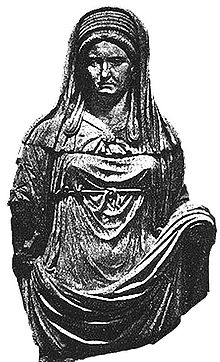

In historicalpolytheism,a priest administers thesacrificeto a deity, often in highly elaborateritual.In theAncient Near East,the priesthood also acted on behalf of the deities in managing their property.
Priestesses in antiquity often performedsacred prostitution,and in Ancient Greece, some priestesses such asPythia,priestess atDelphi,acted asoracles.
Ancient priests and priestesses
[edit]- Sumerianen(Akkadian:entu), includingEnheduanna(c. 23rd century BCE), were top-ranking priests who were distinguished with special ceremonial attire and held equal status to high priests. They owned property, transacted business, and initiated thehieros gamoswith priests and kings.[5]
- Nadītuserved as priestesses in the temples ofInannain the city ofUruk.They were recruited from the highest families in the land and were supposed to remain childless, owned property, and transacted business.
- The Sumerian wordnin,EREŠin Akkadian, is the sign for "lady."nin.dingir(Akkadianentu), literally "divine lady", a priestess.
- In Sumerian epic texts such as "Enmerkar and the Lord of Aratta",nu-gigwere priestesses in temples dedicated to Inanna and may be a reference to the goddess herself.[6]
- PuabiofUrwas an Akkadianqueen regnantor a priestess. In several other Sumerian city-states, the ruling governor or king was also a head priest with the rank ofensi,such as atLagash.
- Control of the holy city ofNippurand its temple priesthood generally meant hegemony over most of Sumer, as listed on theSumerian King List;at one point, the Nippur priesthood conferred the title of queen of Sumer on Kugbau, a popular taverness from nearbyKish(who was later deified asKubaba).
- In theHebrew Bible,Hebrew:קְדֵשָׁהqědēšā,[7]derived from the rootQ-D-Š[8]were sacred prostitutes usually associated with the goddessAsherah.
- Quadishtuserved in the temples of the Sumerian goddessQetesh.
- Ishtarituspecialized in the arts of dancing, music, and singing and they served in the temples ofIshtar.[9]
- In theEpic of Gilgamesh,priestessShamhat,a temple prostitute, tamed wildEnkiduafter "six days and seven nights."
- Gerarai,fourteenAthenianmatrons ofDionysus,presided over sacrifices and participated in the festivals ofAnthesteria.
Ancient Egypt
[edit]Inancient Egyptian religion,the right and obligation to interact with thegodsbelonged to thepharaoh.He delegated this duty to priests, who were effectively bureaucrats authorized to act on his behalf. Priests staffedtemplesthroughout Egypt, giving offerings to thecult imagesin which the gods were believed to take up residence and performing other rituals for their benefit.[10]Little is known about what training may have been required of priests, and the selection of personnel for positions was affected by a tangled set of traditions, although the pharaoh had the final say. In theNew Kingdom of Egypt,when temples owned great estates, the high priests of the most important cult—that ofAmunatKarnak—were important political figures.[11]
High-ranking priestly roles were usually held by men. Women were generally relegated to lower positions in the temple hierarchy, although some held specialized and influential positions, especially that of theGod's Wife of Amun,whose religious importance overshadowed theHigh Priests of Amunin theLate Period.[12]
Ancient Rome
[edit]Inancient Romeand throughout Italy, the ancient sanctuaries ofCeresandProserpinawere invariably led by femalesacerdotes,drawn from women of local and Roman elites. It was the only public priesthood attainable by Roman matrons and was held in great honor.
A Roman matron was any mature woman of the upper class, married or unmarried. Females could serve public cult asVestal Virginsbut few were chosen, and then only from young maidens of the upper class.[13]
Ancient Greece
[edit]- ThePythiawas the title of a priestess at the very ancient temple ofDelphithat was dedicated to theEarth Mother.She was widely credited for herprophecies.The priestess retained her role when the temple was rededicated toApollo,giving her a prominence unusual for a woman in the male-dominated culture ofclassical Greece.
- ThePhrygian Sibylwas the priestess presiding over anApollonianoracleatPhrygia,a historical kingdom in theAnatolianhighlands.
Abrahamic religions
[edit]Judaism
[edit]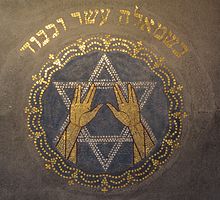
Historical
[edit]Afterthe departure of the Israelites from Egypt,priests inancient Israelwere required by theLaw of Mosesto be directpatrileneal descendantsofAaron,the elder brother ofMoses.In Exodus 30:22–25Godinstructs Moses to make aholy anointing-oilto consecrate the priests "for all of eternity". During the times of the two JewishTemples in Jerusalem,the Aaronic priests performed the daily and specialJewish-holidayofferings and sacrifices within the temples; these offerings are known as thekorbanot.
In Hebrew, the word for "priest" iskohen(singular כהןkohen,plural כּהנִיםkohanim), hence the family namesCohen,Cahn,Kahn,Kohn,Kogan,etc. Jewish families with these names belong to thetribe of Levi(Levites– descended fromLevi,the great-grandfather of Aaron) and in twenty-four instances are called by scripture as such.[14][need quotation to verify]In Hebrew, the word for "priesthood" iskehunnah.
The Hebrew wordkohencomes from therootKWN/KON כ-ו-ן 'to stand, to be ready, established'[15]in the sense of "someone who stands ready before God",[16]and has cognates in otherSemitic languages,e.g.PhoenicianKHN 𐤊𐤄𐤍 "priest"orArabickahinكاهن "priest".
Modern Judaism
[edit]Since thedestruction of the Second Temple,and (therefore) the cessation of the daily and seasonal temple ceremonies and sacrifices,kohanimhave become much less prominent. In traditional Judaism (Orthodox Judaismand to some extent,Conservative Judaism) a few priestly andLeviticalfunctions, such as thepidyon haben(redemption of a first-born son) ceremony and thePriestly Blessing,have been retained. Especially in Orthodox Judaism, kohanim remain subject to a number of restrictions concerning matters related to marriage andritual purity.
Orthodox Judaismregard the kohanim as being held in reserve for a futurerestored Temple.Kohanim do not perform roles of propitiation, sacrifice, or sacrament in any branch ofRabbinical Judaismor inKaraite Judaism.The principal religious function of any kohanim is to perform thePriestly Blessing,although an individual kohen may also become arabbior other professional religious leader.
Beta Israel
[edit]The traditionalBeta Israelcommunity in Israel had little direct contact with other Jewish groups after the destruction of the temple and developed separately for almost two thousand years. While some Beta Israel now follow Rabbinical Jewish practices, the Ethiopian Jewish religious tradition (Haymanot) uses the wordKahento refer to a type non-hereditary cleric.
Samaritanism
[edit]Aaronic Kohanim also officiated at theSamaritantemple onMount Gerizim.The Samaritan kohanim have retained their role as religious leaders.
Christianity
[edit]

With the spread of Christianity and the formation ofparishes,the Greek wordἱερεύς(hiereus), and Latinsacerdos,which Christians had since the 3rd century applied tobishopsand only in a secondary sense topresbyters,began in the 6th century to be used of presbyters,[17]and is today commonly used of presbyters, distinguishing them from bishops.[18]
Today, the term "priest" is used in theCatholic Church,Eastern Orthodoxy,Anglicanism,Oriental Orthodoxy,theChurch of the East,and some branches ofLutheranismto refer to those who have beenordainedto a ministerial position through receiving thesacramentofHoly Orders,although "presbyter" is also used.[19]Since theProtestant Reformation,non-sacramental denominations are more likely to use the term "elder"to refer to their pastors. The Christian term" priest "does not have an entry in theAnchor Bible Dictionary,but the dictionary does deal with the above-mentioned terms under the entry for "Sheep, Shepherd.".[20]
Catholicism and Eastern Orthodoxy
[edit]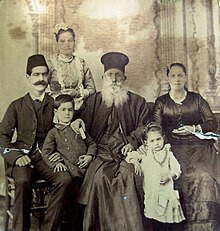
The most significantliturgicalacts reserved to priests in these traditions are the administration of theSacraments,including the celebration of theHoly MassorDivine Liturgy(the terms for the celebration of theEucharistin theLatinand Byzantine traditions, respectively), and theSacrament of Reconciliation,also calledConfession.The sacraments ofAnointing of the Sick(Extreme Unction) andConfirmationare also administered by priests, though in the Western tradition Confirmation is ordinarily celebrated by abishop.In the East, Chrismation is performed by the priest (using oil speciallyconsecratedby a bishop) immediately after Baptism, andUnctionis normally performed by several priests (ideally seven), but may be performed by one if necessary. In the West,Holy Baptismmay be celebrated by anyone. The Vatican catechism states that "According to Latin tradition, the spouses as ministers of Christ's grace mutually confer upon each other the sacrament ofMatrimony".[21]Thus marriage is a sacrament administered by the couple to themselves, but may be witnessed and blessed by a deacon, or priest (who usually administers the ceremony). In the East, Holy Baptism and Marriage (which is called "Crowning" ) may be performed only by a priest. If a person is baptizedin extremis(i.e., when in fear of immediate death), only the actual threefold immersion together with the scriptural words[22]may be performed by a layperson or deacon. The remainder of the rite, andChrismation,must still be performed by a priest, if the person survives. The only sacrament which may be celebrated only by a bishop is that ofOrdination(cheirotonia,"Laying-on of Hands" ), orHoly Orders.[citation needed]
In these traditions, only men who meet certain requirements may become priests. In Catholicism, thecanonicalminimum age is twenty-five. Bishops may dispense with this rule and ordain men up to one year younger. Dispensations of more than a year are reserved to theHoly See(Can. 1031 §§ 1, 4.) A Catholic priest must beincardinatedby his bishop or his major religioussuperiorin order to engage in public ministry.Secular priestsare incardinated into adiocese,whereas religious priests live theconsecrated lifeand can work anywhere in the world that their specific community operates.
In Orthodoxy, the normal minimum age is thirty (Can. 11 of Neocaesarea) but a bishop may dispense with this if needed. In neither tradition may priests marry after ordination. In the Catholic Church, priests in the Latin Church must becelibateexcept under special rules for married clergy converting from certain other Christian confessions.[23]Married men may become priests inEastern Orthodoxyand theEastern Catholic Churches,but in neither case may they marry after ordination, even if they become widowed. Candidates for bishop are chosen only from among the celibate. Orthodox priests will either wear aclerical collarsimilar to the above-mentioned, or simply a very loose black robe that does not have a collar.
Anglican or Episcopalian
[edit]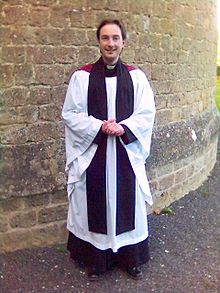
The role of a priest in theAnglican Communionand theFree Church of Englandis largely the same as within theRoman Catholic ChurchandEastern Christianity,except thatcanon lawin almost everyAnglicanprovince restricts the administration ofconfirmationto thebishop,just as withordination.Although Anglican priests who are members ofreligious ordersmust remaincelibate(although there are exceptions, such as priests in theAnglican Order of Cistercians), thesecular clergy—bishops, priests, and deacons who are not members of religious orders—are permitted to marry before or after ordination (although in most provinces they are not permitted tomarry a person of the same sex). The Anglican churches, unlike the Roman Catholic orEastern Christiantraditions, have allowed the ordination of women as priests (referred to as "priests" not "priestesses" ) in some provinces since 1971.[24]This practice remains controversial, however; a minority of provinces (10 out of the 38 worldwide) retain an all-male priesthood.[25]MostContinuing Anglicanchurches do not ordain women to the priesthood.
As Anglicanism represents a broad range of theological opinion, itspresbyterateincludes priests who consider themselves no different in any respect from those of the Roman Catholic Church, and a minority who prefer to use the titlepresbyterin order to distance themselves from the more sacrificial theological implications which they associate with the wordpriest.
Whilepriestis the official title of a member of the presbyterate in every Anglican province worldwide (retained by the Elizabethan Settlement), the ordination rite of certain provinces (including theChurch of England) recognizes the breadth of opinion by adopting the titleThe Ordination of Priests (also called Presbyters).Even though both words mean 'elders' historically the termpriesthas been more associated with the "High Church"orAnglo-Catholicwing, whereas the term "minister"has been more commonly used in"Low Church"or Evangelical circles.[26]
Lutheranism
[edit]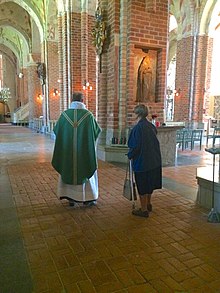
The general priesthood or thepriesthood of all believers,is aChristiandoctrine derived from several passages of theNew Testament.It is a foundational concept ofProtestantism.[27]It is this doctrine thatMartin Lutheradduces in his 1520To the Christian Nobility of the German Nationin order to dismiss the medieval Christian belief that Christians were to be divided into two classes: "spiritual" and "temporal" or non-spiritual. Conservative Lutheran reforms are reflected in the theological and practical view of the ministry of the church. Much of European Lutheranism follows the traditional Catholic governance of deacon, presbyter, and bishop. The Lutheran archbishops of Finland, Sweden, etc. and Baltic countries are the historic national primates and some ancient cathedrals and parishes in the Lutheran church were constructed many centuries before the Reformation. Indeed, ecumenical work within the Anglican Communion and among Scandinavian Lutherans mutually recognize thehistoric apostolic legitimacyandfull communion.Likewise in America, Lutherans have embraced the apostolic succession of bishops in the full communion with Episcopalians and most Lutheran ordinations are performed by a bishop.
TheChurch of Swedenhas a threefold ministry of bishop, priest, and deacon and those ordained to the presbyterate are referred to as priests.[28]In theEvangelical Lutheran Church of Finland,ordained presbyters are referred to by various publications, including Finnish ones, as pastors,[29][30]or priests.[31][32]In the United States, denominations like theLutheran Church–Missouri Synoduse the terms "reverend" and "pastor" interchangeably for ordained members of the clergy.[33]
Methodism
[edit]Methodistclergyoften have the title ofpastor,minister,reverend,etc.
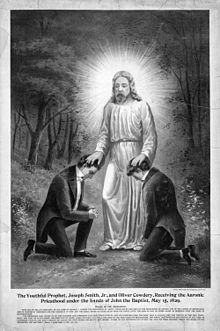
Latter Day Saints
[edit]In theLatter Day Saint movement,the priesthood is the power and authority of God given to man, including the authority to performordinancesand to act as a leader in the church. A body of priesthood holders is referred to as aquorum.Priesthood denotes elements of both power and authority. The priesthood includes the powerJesusgave hisapostlesto perform miracles such as the casting out of devils and the healing of sick (Luke9:1). Latter Day Saints believe that theBiblicalmiracles performed byprophetsand apostles were performed by the power of the priesthood, including the miracles of Jesus, who holds all of the keys of the priesthood. The priesthood is formally known as the "Priesthood after the Order of the Son of God", but to avoid the too frequent use of the name of deity, the priesthood is referred to as the Melchizedek priesthood (Melchizedekbeing the high priest to whomAbrahampaid tithes). As an authority, the priesthood is the authority by which a bearer may perform ecclesiastical acts of service in the name of God. Latter Day Saints believe that acts (and in particular,ordinances) performed by one with priesthood authority are recognized by God and are binding in heaven, on earth, and in the afterlife.
There is some variation among the Latter Day Saint denominations regarding who can be ordained to the priesthood. Inthe Church of Jesus Christ of Latter-day Saints(LDS Church), all worthy males above the age of 12 can be ordained to the priesthood. However, prior to apolicy change in 1978,the LDS Church did not ordain men or boys who were of black African descent. The LDS Church does not ordain women to any of its priesthood offices. The Reorganized Church of Jesus Christ of Latter Day Saints (now the Community of Christ), the second largest denomination of the movement, began ordaining women to all of its priesthood offices in 1984. This decision was one of the reasons that led to a schism in the church, which prompted the formation of the independentRestoration Branchesmovement from which other denominations have sprung, including theRemnant Church of Jesus Christ of Latter Day Saints.
Islam
[edit]Islam has nosacerdotalpriesthood. There are, however, a variety of academic and administrative offices which have evolved to assist Muslims with this task, such as theimāmsand themullāhs.
Mandaeism
[edit]AMandaean priestrefers to an ordained religious leader inMandaeism.InMandaean scriptures,priests are referred to asNaṣuraiia(Naṣoraeans).[34]All priests must undergo lengthy ordination ceremonies, beginning withtarmidainitiation.[35]Mandaean religious leaders and copyists of religious texts hold the titleRabbior in Arabic 'Sheikh'.[36][37]
All Mandaean communities traditionally require the presence of a priest, since priests are required to officiate over all important religious rituals, includingmasbuta,masiqta,birth and wedding ceremonies. Priests also serve as teachers, scribes, and community leaders.[35]
There are three types of priests inMandaeism:[35]
- rišama"leader of the people"
- ganzibria"treasurers" (from Old Persianganza-bara"id.," Neo-Mandaicganzeḇrānā)
- tarmidia"disciples" (Neo-Mandaictarmidānā)
Priests have lineages based on the succession ofganzibriapriests who had initiated them. Priestly lineages, which are distinct from birth lineages, are typically recorded in thecolophonsof manyMandaean texts.The position is not hereditary, and any Mandaean male who is highly knowledgeable about religious matters is eligible to become a priest.[38]
Eastern religions
[edit]
Hinduism
[edit]AHindupriest traditionally comes from theBrahmincommunity.[39][40]Priests are ordained and trained as well. There are two types of Hindu priests,pujaris(swamis,yogis,andgurus) andpurohitas(pandits). Apujariperforms rituals in a temple. These rituals include bathing themurtis (the statues of the gods/goddesses), performingpuja,a ritualistic offering of various items to the gods, the waving of agheeor oil lamp also called an offering in light, known in Hinduism asaarti,before themurtis.Pujarisare often married.
Apurohita,on the other hand, performs rituals andsaṃskāras(sacraments),yajnas(sacrifices) outside of the temple. There are specialpurohitaswho perform only funeral rites.
In many cases, apurohitaalso functions as apujari.
While only men have traditionally been ordained as priests in the past, recent developments such as feminism in India have led to the opening of training schools for women to become priests.[41]
Zoroastrianism
[edit]A Zoroastrian priest are called a Mobad and they officiate theYasna,pouring libations into the sacred fire to the accompaniment of ritual chants. The Mobad also prepare drinks for thehaomaritual.[42]
In IndianZoroastrianism,the priesthood is reserved for men and is a mostly hereditary position,[43]but women have been ordained in Iran and North America as a mobedyar, meaning an assistant mobed.[44][45]
Taoism
[edit]
TheTaoist priests( đạo sĩ "master of theDao"p. 488) act as interpreters of the principles of Yin-Yang5 elements(fire, water, soil, wood, and metal p. 53) school of ancient Chinese philosophy, as they relate to marriage, death, festival cycles, and so on. The Taoist priest seeks to share the benefits of meditation with his or her community through public ritual and liturgy (p. 326). In the ancient priesthood before the Tang, the priest was calledJijiu( "libationer" p. 550), with both male and female practitioners selected by merit. The system gradually changed into a male only hereditary Taoist priesthood until more recent times (p. 550,551).[46]
Indigenous and ethnic religions
[edit]Shinto
[edit]This articleneeds additional citations forverification.(February 2012) |

The Shinto priest is called akannushi(Thần chủ,lit. "Master of thekami"),originally pronouncedkamunushi,sometimes referred to as ashinshoku(Thần chức).A kannushi is the person responsible for the maintenance of a Shinto shrine, orjinja,purificatory rites, and for leading worship and veneration of a certainkami.Additionally,kannushiare aided by another priest class,miko(Vu nữ,"shrine maidens" ),for many rites. The maidens may either be family members in training, apprentices, or local volunteers.
Saiinwere female relatives of the Japanese emperor (termedsaiō) who served as High Priestesses inKamo Shrine.Saiōalso served atIse Shrine.Saiinpriestesses usually were elected from royalty. In principle,Saiinremained unmarried, but there were exceptions. SomeSaiinbecameconsortsof the emperor, calledNyōgoin Japanese. TheSaiinorder of priestesses existed throughout the Heian and Kamakura periods.
Africa
[edit]TheYoruba peopleof westernNigeriapractice an indigenous religion with achieflyhierarchy of priests and priestesses that dates to AD 800–1000.[47]Ifá priests and priestesses bear the titlesBabalawofor men andIyanifafor women.[48]Priests and priestesses of the variedOrishaare titled Babalorisa for men and Iyalorisa for women.[49]Initiates are also given an Orisa or Ifá name that signifies under which deity they are initiated. For example, a Priestess ofOsunmay be named Osunyemi, and a Priest ofIfámay be named Ifáyemi. This traditional culture continues to this day as initiates from all around the world return to Nigeria for initiation into the priesthood, and varied derivative sects in the New World (such asCubanSanteríaand BrazilianUmbanda) use the same titles to refer to their officers as well.
Afro-Latin American religions
[edit]In Brazil, the priests in theUmbanda,CandombléandQuimbandareligions are calledpai-de-santo(literally "Father of saint" in English), or "babalorixá" (a word borrowed fromYorubabàbálórìsà,meaningFather of theOrisha); its female equivalent is themãe-de-santo( "Mother of saint" ), also referred to as "ialorixá" (Yoruba:iyálórìsà).
In theCubanSantería,a male priest is calledSantero,while female priests are calledIyanifasor "mothers of wisdom".[50]
Neo-paganism
[edit]Wicca
[edit]
According to traditionalWiccanbeliefs, every member of the religion is considered a priestess or priest, as it is believed that no person can stand between another and the divine. However, in response to the growing number of Wiccan temples andchurches,several denominations of the religion have begun to develop a core group of ordained priestesses and priests serving a larger laity. This trend is far from widespread, but is gaining acceptance due to increased interest in the religion.[51][52][53]
Dress
[edit]

The dress of religious workers in ancient times may be demonstrated in frescoes and artifacts from the cultures. The dress is presumed to be related to the customary clothing of the culture, with some symbol of the deity worn on the head or held by the person. Sometimes special colors, materials, or patterns distinguish celebrants, as the white wool veil draped on the head of theVestal Virgins.
Occasionally, the celebrants at religious ceremonies shed all clothes in a symbolic gesture of purity. This was often the case in ancient times. An example of this is shown to the left on a Kylix dating from c. 500 BC where a priestess is featured. Modern religious groups tend to avoid such symbolism and some may be quite uncomfortable with the concept.
The retention of longskirtsandvestmentsamong many ranks of contemporary priests when they officiate may be interpreted to express the ancient traditions of the cultures from which their religious practices arose.
In most Christian traditions, priests wearclerical clothing,a distinctive form of street dress. Even within individual traditions it varies considerably in form, depending on the specific occasion. InWestern Christianity,the stiff whiteclerical collarhas become the nearly universal feature of priestly clerical clothing, worn either with acassockor aclergy shirt.The collar may be either a full collar or a vestigial tab displayed through a square cutout in the shirt collar.
Eastern Christianpriests mostly retain the traditional dress of two layers of differently cut cassock: therasson(Greek) orpodriasnik(Russian) beneath the outerexorasson(Greek) orriasa(Russian). If a pectoral cross has been awarded it is usually worn with street clothes in the Russian tradition, but not so often in the Greek tradition.
Distinctive clerical clothing is less often worn in modern times than formerly, and in many cases it is rare for a priest to wear it when not acting in a pastoral capacity, especially in countries that view themselves as largely secular in nature. There are frequent exceptions to this however, and many priests rarely if ever go out in public without it, especially in countries where their religion makes up a clear majority of the population.Pope John Paul IIoften instructed Catholic priests and religious to always wear their distinctive (clerical) clothing, unless wearing it would result in persecution or grave verbal attacks.
Christian traditions that retain the title of priest also retain the tradition of special liturgicalvestmentsworn only during services. Vestments vary widely among the different Christian traditions.
In modernPaganreligions, such asWicca,there is no one specific form of dress designated for the clergy. If there is, it is a particular of the denomination in question, and not a universal practice. However, there is a traditional form of dress, (usually a floor-lengthtunicand a knotted cordcincture,known as thecingulum), which is often worn by worshipers during religious rites. Among those traditions of Wicca that do dictate a specific form of dress for its clergy, they usually wear the traditional tunic in addition to other articles of clothing (such as an open-frontedrobeor acloak) as a distinctive form of religious dress, similar to ahabit.[54][55]
Assistant priest
[edit]In many religions, there are one or more layers of assistant priests.
In theAncient Near East,hierodulesserved in temples as assistants to the priestess.
In ancient Judaism, the Priests (Kohanim) had a whole class of Levites as their assistants in making the sacrifices, in singingpsalmsand in maintaining theTemple.The Priests and the Levites were in turn served by servants calledNethinim.These lowest level of servants were not priests.
An assistant priest is a priest in the Anglican and Episcopal churches who is not the senior member of clergy of the parish to which they are appointed, but is nonetheless in priests' orders; there is no difference in function or theology, merely in 'grade' or 'rank'. Some assistant priests have a "sector ministry", that is to say that they specialize in a certain area of ministry within the local church, for example youth work, hospital work, or ministry to local light industry. They may also hold some diocesan appointment part-time. In most (though not all) cases, an assistant priest has the legal status ofassistant curate,although not all assistant curates are priests, as this legal status also applies to manydeaconsworking as assistants in a parochial setting.
The corresponding term in theCatholic Churchis "parochial vicar" – an ordained priest assigned to assist the pastor (Latin:parochus) of a parish in the pastoral care of parishioners. Normally, all pastors are also ordained priests; occasionally an auxiliary bishop will be assigned that role.
InWicca,the leader of acovenor temple (either a high priestess or high priest) often appoints an assistant. This assistant is often called a 'deputy', but the more traditional terms 'maiden' (when female and assisting a high priestess) and 'summoner' (when male and assisting a high priest) are still used in many denominations.
See also
[edit]References
[edit]- ^Momigliano, Arnaldo (1984)."Georges Dumézil and the Trifunctional Approach to Roman Civilization".History and Theory.23(3): 312–330.doi:10.2307/2505078.ISSN0018-2656.JSTOR2505078.
- ^Webster's New World Dictionary of the American Language,College Edition, The World Publishing Company, Cleveland OH, s.v. "priest"
- ^"priest".Online Etymology Dictionary.
- ^Joseph B. Lightfoot,Epistle to the Philippians; a revised text, with introduction, etc.,2nd ed. 1869, p. 184, cited afterOED.
- ^Dening, Sarah (1996).The Mythology of Sex – Ch.3.Macmillan.ISBN978-0-02-861207-2.
- ^Black, Jeremy (1998).Reading Sumerian Poetry.Cambridge University Press.p. 142.ISBN0-485-93003-X.
- ^"Hebrew Lexicon:: H6948 (KJV)".cf.blueletterbible.org. Archived fromthe originalon 2012-07-10.Retrieved2015-07-25.
- ^"Strong's H6948".Blue Letter Bible.Archived fromthe originalon 2018-08-29.Retrieved2018-08-29.,incorporatingStrong's Concordance(1890) andGesenius's Lexicon (1857).
- ^Prioreschi, Plinio (1996).A History of Medicine: Primitive and ancient medicine.Vol. 1. Horatius Press. p. 376.ISBN978-1-888456-01-1.PMID11639620.
{{cite book}}:|journal=ignored (help) - ^Sauneron, Serge(2000).The Priests of Ancient Egypt.Cornell University Press. pp. 32–36, 89–92.ISBN0-8014-8654-8.
- ^Sauneron, Serge(2000).The Priests of Ancient Egypt.Cornell University Press. pp. 42–47, 52–53.ISBN0-8014-8654-8.
- ^Doxey, Denise M., "Priesthood", inThe Oxford Encyclopedia of Ancient Egypt(2001), vol. III, pp. 69–70
- ^Barbette Stanley Spaeth,The Roman goddess Ceres,University of Texas Press, 1996, pp. 4–5, 9, 20 (historical overview and Aventine priesthoods), 84–89 (functions of plebeian aediles), 104–106 (women as priestesses): citing among others Cicero,In Verres,2.4.108; Valerius Maximus, 1.1.1; Plutarch,De Mulierum Virtutibus,26.
- ^Jerusalem TalmudtoMishnaictractate Maaser Sheini p. 31a.
- ^Even-Shoshan, Avraham (2003).Even-Shoshan Dictionary.pp. Entry "כֹּהֵן" (Kohen).
- ^"Klein Dictionary, כֹּהֵן".www.sefaria.org.Retrieved2020-08-01.
- ^Garhammer, Erich (2005)."Priest, Priesthood 3. Roman Catholicism".In Erwin Fahlbusch (ed.).Encyclopedia of Christianity.Vol. 4. Wm. B. Eerdmans Publishing. p. 348.ISBN978-0-8028-2416-5.Retrieved2012-06-20.
- ^"Dennis Chester Smolarski,Sacred Mysteries(Paulist Press 1995 ISBN 978-0-8091-3551-6), p. 128 ".Retrieved2014-08-25.
- ^An example of the use of "presbyter" is found inCatechism of the Catholic Church, 1554
- ^Vancil, Jack W. (1992). "Sheep, Shepherd"The Anchor Bible DictionaryNew York: Doubleday. 5, 1187–1190.ISBN0-385-19363-7.
- ^"Catechism of the Catholic Church – The sacrament of Matrimony".vatican.va.Retrieved2015-07-25.
- ^Matthew 28:19
- ^Miller, Michael (May 17, 2008)."Peoria diocese ordains its first married priest".Peoria Journal Star.p. C8.Retrieved2013-06-14.
About 100Episcopalpriests, many of them married, have become Roman Catholic priests since a "pastoral provision" was created byPope John Paul IIin 1980, said [Doug] Grandon, director of catechetics for the diocese. [...] His family life will remain the same, he said. Contrary to popular misunderstandings, he won't have to be celibate.
- ^Emma John (July 4, 2010)."Should women ever be bishops?".The Observer.London.
- ^Sulaiman Kakaire."Male bishops speak out on female priests".
- ^Anglican Church of Canada."Minister or Priest?".
- ^"The Protestant Heritage".Encyclopædia Britannica.2007. Archived fromthe originalon June 14, 2006.Retrieved2007-09-20.
- ^"Ministry and Ministries – Svenska kyrkan".Svenskakyrkan.se. 2021-09-20.Retrieved2022-03-18.
- ^"Parishes".evl.fi.Retrieved2022-03-18.
- ^"Women ordained for thirty years".evl.fi. 1988-03-06.Retrieved2022-03-18.
- ^Sequeira, Tahira (8 February 2021)."Gallery: Turku makes history with first female bishop".Helsinki Times.Retrieved13 May2021.
Leppänen also became the first woman from the Conservative Laestadian movement (a revival movement within the Evangelical Lutheran Church of Finland) to be ordained as a priest in 2012. The first female priests were ordained in Finland 32 years ago.
- ^Doe, Norman (4 August 2011).Law and Religion in Europe.Oxford University Press. p. 135.ISBN978-0-19-960401-2.
In Finland, a priest of the Lutheran church is forbidden to reveal a secret received in confession and in the course of pastoral counselling; a similar rule applies to Orthodox priests.
- ^"Paramount Christian".www.paramountchristian.org.Retrieved2022-12-20.
- ^Drower, E. S. 1960.The Secret Adam: A Study of Nasoraean Gnosis.Oxford: Clarendon Press.
- ^abcBuckley, Jorunn Jacobsen (2002).The Mandaeans: ancient texts and modern people(PDF).New York: Oxford University Press.ISBN0-19-515385-5.OCLC65198443.
- ^McGrath, James F. (2010)."Reading the Story of Miriai on Two Levels: Evidence from Mandaean Anti-Jewish Polemic about the Origins and Setting of Early Mandaeism".ARAM Periodical.pp. 583–592.Retrieved10 December2021.
- ^Holy Spirit University of Kaslik – USEK (27 November 2017),"Open discussion with the Sabaeans Mandaeans",YouTube,retrieved10 December2021
- ^Buckley, Jorunn Jacobsen (2010).The great stem of souls: reconstructing Mandaean history.Piscataway, NJ: Gorgias Press.ISBN978-1-59333-621-9.
- ^Herman, A. L. (2018-05-04).A Brief Introduction To Hinduism: Religion, Philosophy, And Ways Of Liberation.Routledge. p. 52.ISBN978-0-429-98238-5.
- ^Parsons, Gerald (1993).The Growth of Religious Diversity: Traditions.Psychology Press. p. 197.ISBN978-0-415-08326-3.
- ^Klostermaier, Klaus K. (2010-03-10).A Survey of Hinduism: Third Edition.State University of New York Press. p. 324.ISBN978-0-7914-8011-3.
- ^Boyce, Mary (2001) [1979].Zoroastrians, their religious beliefs and practices.London:Routledge.ISBN0-415-23902-8.
- ^Nigosian, Solomon Alexander (1993),The Zoroastrian Faith: Tradition and Modern Research,Montreal, Quebec:McGill-Queen's University Press,p.104,ISBN0-7735-1144-X,OCLC243566889
- ^Wadia, Arzan Sam (March 9, 2011),"The Jury Is Still Out On Women as Parsi Priests",parsikhabar.net,Parsi Khabar
- ^Khosraviani, Mahshad (June 19, 2013),"Sedreh Pooshi by Female Mobedyar in Toronto-Canada",parsinews.net,Parsi News, archived fromthe originalon October 9, 2014,retrievedOctober 10,2014
- ^Pregadio, Fabrizio (2008)The Encyclopedia of Taoism, Volume 1Psychology PressISBN0700712003
- at Google books:pp. 488–90•pp. 53–54•pp. 326–29•pp. 550–51
- ^Akintoye, S. A. (2010).A History of the Yoruba People.Dakar, Senegal.ISBN978-2-35926-005-2.OCLC609888714.
{{cite book}}:CS1 maint: location missing publisher (link) - ^Asante, M.K.; Mazama, A. (2009).Encyclopedia of African Religion.Vol. 1. SAGE Publications.ISBN978-1-4129-3636-1.Retrieved2015-07-25.
- ^Walter, M.N.; Fridman, E.J.N. (2004).Shamanism: An Encyclopedia of World Beliefs, Practices, and Culture.Vol. 1. ABC-CLIO. p. 451.ISBN978-1-57607-645-3.Retrieved2015-07-25.
- ^AfricaNews (October 10, 2022)."The Cuban priestesses defying religious patriarchy".Africanews.Retrieved2022-12-20.
- ^"Priesthood".Paganwiccan.about.com. 2014-03-04. Archived fromthe originalon 2014-08-26.Retrieved2014-08-25.
- ^"Leadership".Patheos.com.Retrieved2014-08-25.
- ^"The Priesthood – Temple of the Good Game".Goodgame.org.nz. Archived fromthe originalon 2014-07-02.Retrieved2014-08-25.
- ^Kennerson, Robert (2022-12-17)."The Garb Of The Clergy – Pagan Christianity".Wilmington For Christ.Retrieved2022-12-20.
- ^Beckett, John (2017-02-12)."How Should Pagan Clergy Dress?".John Beckett.Retrieved2022-12-20.
External links
[edit]- Descriptionof the problem of Roman Catholic and Old Catholic reunion with respect to the female priesthood
- Chisholm, Hugh,ed. (1911)..Encyclopædia Britannica(11th ed.). Cambridge University Press.
- Herbermann, Charles, ed. (1913)..Catholic Encyclopedia.New York: Robert Appleton Company.
